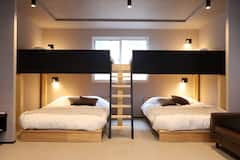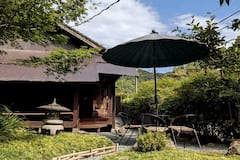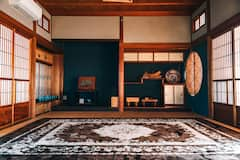Who knew there was a top three list of Japan’s best onsens (hot springs) in the 17th century? Though I’d never heard of Hayashi Razan, he was a famous Kyoto-based poet/philosopher in the 16th and 17th centuries. Hayashi listed the top three onsens long before such lists became popular. It seems these same three onsens, Arima, Kusatsu, and Gero are still considered the best in a country that treasures such hot water pursuits.
I stumbled upon this knowledge on my 9th trip to Japan in 2017. My in-laws set us up with an itinerary that included Gero Onsen as part of a late-winter trip. Being curious about Gero, I researched this mountain town and found the start of a “Three Best Onsen” trail. We live in an era of “listicles” where travel writers tell about the best of any area’s top attractions, dining, etc., but I never really had come across such things from ancient times that still apply to travelers today.
What is an onsen? (from USD 348)

For those of you who are not familiar with onsen, they are mainly developed natural hot springs that come in many shapes and sizes. Take for instance, Noboribetsu in Hokkaido, a Las Vegas-like hotel complex built next to an active volcano. Noboribetsu is a flashy onsen resort packed with modern comforts. Then there are dozens of smaller under-developed onsens scattered throughout Japan. I’ve enjoyed every onsen visited on past trips. Now that I’ve been to the best, I agree with Razan on the top three.
Our trip to Gero Onsen started by a Shinkansen train journey from Kanazawa, and then a short local rail line to Gero. The town itself is set along the Hida River and has many mid-rise buildings that are nothing special. What’s special is the three public bathhouses and over 25 participating ryokans (traditional lodges). We chose Yunoshimakan, established in 1931, where two past emperors have stayed. This rustic ryokan is at the top of a steep mountain road on the edge of a dense and fragrant forest. Yunoshimakan overlooks Gero and features natural hot spring water in its public and private baths.
While Yunoshimakan is a bit old and well-worn, I’d highly recommend it for its rural feel. Unlike the hotels and ryokans below, Yunoshimakan feels like a mountain lodge in the middle of nowhere. The public baths are a mix of modern tile-floored indoor baths and outdoor stone-floor baths surrounded by huge boulders and traditional landscaping.
Yunoshimakan
Address: Yunoshima 645
151.36 km (94.1 mi) from Yubatake
Be sure and order an in-room kaiseki dinner

Like most onsens, men and women’s baths are separated. Don’t bother bringing a bathing suit as these are nude-only. For the overly modest, there are private onsen rooms with tubs on the balcony overlooking the town. Imagine sitting in your private tub listening to the wind in the cedar forest with birdsong adding to the natural soundtrack while blissfully soaking. Not many onsens can offer this mountainside experience with above-town views.
To complete the traditional ryokan onsen experience, try kaiseki dining in your room. A server appears at the appointed time and sets up your in-room dining table. A parade of delicious local food is brought to you in some of the most decorative plates, bowls, and tiny cups you’ll ever see. Delight in sushi, grilled anago (eel), soup, pickled vegetables, Kobe beef, and other delicious traditional fare. You should order hot sake, Japanese beer, or French wine to pair with the feast. This meal will be one of the most memorable experiences of your trip; most onsen hotels offer this type of dining.
Saving the best for last (from USD 159)

The last onsen stop of the 2018 trip proved to be my favorite. Kusatsu was reached by taking a JR Bus from Tokyo on a four-hour ride. Our bus driver politely announced in Japanese, “I’m sorry but there has been an accident on the highway to Kusatsu. We will be taking an alternate route that will make us about 40 minutes late.” It turned out to be over an hour late, but the scenery was gorgeous with fall colors lighting up mountainsides most of the way. Trees bare of leaves still supported bright orange-colored persimmons in backyards of small towns along the route.
We arrived at Kusatsu just in time to check into Kanemidori Ryokan and walk to the center of town to catch the water mixing ceremony. For 500 JPY each we got to watch a re-enactment of an ancient mixing method that allowed bathers to enjoy the hot springs without being cooked. The water comes from the source at over 90 degrees centigrade/194 fahrenheit! The clever locals figured out how to mix cooled hot spring water with the hot water to make it bearable to soak in.
Kanemidori
Address: Kusatsu 162
189 meters (0.2 ft) from Yubatake
You might be interested in these Airbnbs!
Yakitori and footbaths

After the show, we saw a line of customers waiting for yakitori just down the street next to the Yubatake (hot springs field). We queued up, and after a fifteen-minute wait, ordered six sticks of delicious grilled chicken thighs and breast. When in doubt where to eat, just look for a line of customers!
The Kusatsu hot springs water has a low ph of 2.1 and puts out an impressive amount of water. It is said some 32,000 liters/8,453 gallons flows per minute! The town has dozens of lodging options to choose from. We chose the Kanemidori Ryokan, a 130+-year-old establishment known for its history and elegance.
A five-minute walk to the middle of town made it easy to get to the public footbath next to the Yubatake where I dunked my hands in for the first feel of this curative water. Yubatake is where the gushing hot springs water flows down a series of wooden troughs to be distributed throughout the town’s hotels and pools. Kusatsu is endowed with a less-developed look and feel than most other onsen towns. There are 13 small public hot pools in town that the locals maintain. For directions, stop by the visitor’s center at the bus station and ask for a map of the area.
I spoke with Shihomi Kawashima at the visitor’s center who circled the public baths on my map. It was fun searching for these pools during my brief stay. The most popular seemed to be the footbath next to the Yubatake. With a low pH, this water possesses health-giving properties providing relief of neuralgia, skin conditions, diabetes, sprains, and bruises, to name a few. The water is a bit stinky with its sulfurous odor wrinkling some noses, but in the name of good health, I soaked it up.
One night is not enough
As the trip came to a close I thought Kusatsu had the best shops (The Glass Works), ryokan, and hot springs of all my trips to Japan. On my next trip I plan on spending at least two nights to finish exploring this tiny town. One night was not even close to enough time to soak up this famous hot springs town.
History
Get Trip101 in your inbox
Unsubscribe in one click. See our Privacy Policy for more information on how we use your data






















Create an account to